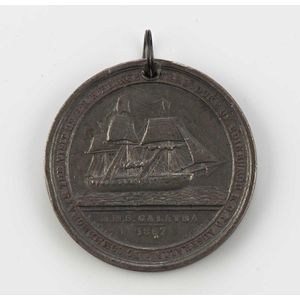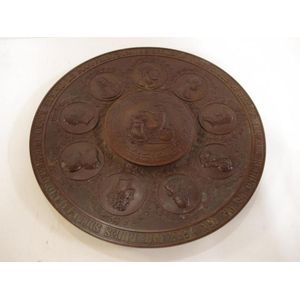Neo-Classical Bronze Comport by F.L. Vombach
You must be a subscriber, and be logged in to view price and dealer details.
Subscribe Now to view actual auction price for this item
When you subscribe, you have the option of setting the currency in which to display prices to $Au, $US, $NZ or Stg.
- Embossed / Repousse - Embossing, also known as repousse, is the technique of decorating metal with raised designs, by pressing or beating out the design from the reverse side of the object.It is the opposite of chasing, where the decoration is applied from the front. An embossed or repoussed object may have chasing applied to finish off the design.
- Neo Classical - The period or style, known as "neo-classical", was based on Greek and Roman designs and motifs, and is usually associated with the influence of the four Adam brothers, but principally Robert Adam, the second oldest of the brothers, who were architects and designers, active in the latter half ot the 18th century (1760s to 1790s).
Born in Scotland in 1728, Robert Adam spent time in Italy studying and his designs are influenced by the finds made during the excavation of Pompei.
When he returned to England he became the Court Architect to George III (1738-1820).
In turn, designs by Adam then influenced Hepplewhite.
Neo-classical ornamentation is characterised by use of classical urns, palmettes, mythical creatures such as the sphinx and griffin, ram's heads, swags, scrolling foliage, and use of the Greek key pattern. - Bronze - An alloy of copper and tin, traditionally in the proportions of about 9 parts of copper to 1 part of tin.
The discovery of bronze in Western Asia in the 4th century enabled people to create metal objects which were superior to those previoulsy possible because of its strength and hardness, and it has been used throughout the world for weapons, coins, tools, statuary and other decorative items.
It is very fluid in a molten state, and its hardness, strength when set, and non-corrosive properties makes it most suitable for casting sculpture.
This item has been included into following indexes:
Visually similar items

A 1887 Victoria Jubilee medal, Stokes Melbourne and a HMS Galatea Medal, 1867

Victorian bronze inkwell inscribed 'Art Union of London', central well surrounded by 9 circular busts of Great Men, 32 cm diameter approx.

Prize medallion; 39 mm in bronze by Amor. 'Patience, Work and God's Grace' on reverse. The Exhibition's motto was 'Patience, Work and God's Grace'. It included auctions, cooking demonstrations, lectures on food and temperance, concerts, dramatic performanc

An intricately rose engine tuned circular table snuff box, of finely grained timber, the circular lid engraved with four quadrants displaying unique patterns framing a central silver cartouche, the base engraved with a concentric turned design. Diameter 10
